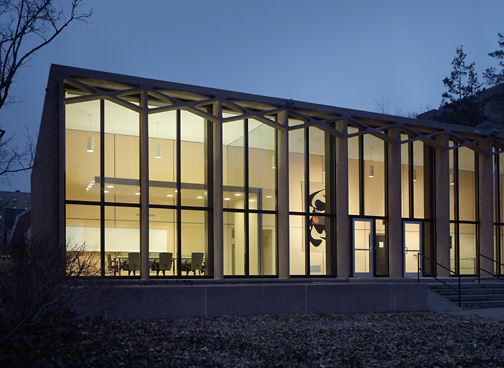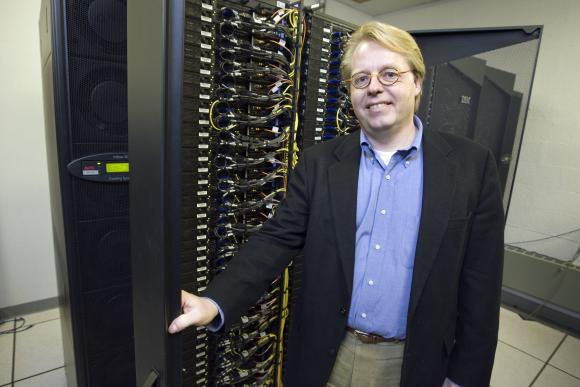PROVIDENCE, R.I. [Brown University] — Brown University and IBM (NYSE: IBM) today are announcing the opening of a multimillion-dollar supercomputer at Brown’s Center for Computation and Visualization. The supercomputer is the most powerful computational system in Rhode Island and will be used by researchers statewide to tackle “grand challenges” affecting Ocean State residents in climate change, education, energy and health.
Brown and IBM will work with government, universities, hospitals, nonprofit organizations, businesses and other entities in Rhode Island on using the supercomputer.
To better define which challenges will be undertaken, Brown and IBM during the next several months will host a series of symposia involving world-class scientific experts to discuss how the supercomputer can be used to tackle pressing societal problems in Rhode Island.
“Combined, the supercomputer and the symposia allow us to begin to tackle our state’s most sobering challenges, thus allowing for economic growth and stability through productivity, innovation and competitiveness,” said Clyde Briant, vice president for research at Brown.
The new supercomputer can perform more than 14 trillion calculations per second — nearly 50 times faster than what had been available at Brown — making it the most powerful computing system in Rhode Island, according to IBM. The system operates at a peak performance speed of more than 14 teraflops, widely considered to meet supercomputer standards, although below the threshold for inclusion in the Top 500 list of supercomputers.
Examples of the wide areas of research that will take advantage of the increased computing horsepower include advances in genomics that could lead to drugs for treating specific diseases such as cancer; investigation of the mechanics of human and animal movement; exploration of the web of animal life and ocean ecosystems; and studies of the terrain of planetary bodies, such as Mars.
“We live in an era where computer-enabled research cuts across all research and opens entirely new pursuits and innovations. However, this work demands greater computational capacity in terms of speed and the ability to handle large amounts of data,” said Jan Hesthaven, professor of applied mathematics and director of the Center for Computation and Visualization. “We now have a computing system for these times.”

The benefits to faculty and graduate researchers are many. Research projects that involve intricate, voluminous datasets will be executed on campus, rather than having to be done elsewhere. The supercomputer also enhances research that involves multiple departments, capitalizing on Brown’s strength in interdisciplinary research, as well as increasing funding opportunities for major research initiatives.
“This new system will also help scientists make our world smarter through the ability to address problems that are orders of magnitude larger than what they could address just a few short years ago — from mapping the human genome to helping figure out how to cut down on carbon emissions to helping ensure our waters and food are safe and sustainable,” said Nick Bowen, vice president of technology, IBM.
Researchers at the University of Rhode Island and the Marine Biological Laboratory in Woods Hole, Mass., who helped to design the supercomputer, will be among its first users.
“This system will transform my ability to analyze the genomes of microbes in the ocean,” said Bethany Jenkins, an assistant professor at the University of Rhode Island’s Department of Molecular and Cell Biology and Graduate School of Oceanography. “Having the most advanced computing resources is essential to make sure Rhode Island researchers remain leaders in studying the environment.”
Next year, the supercomputer is expected to be available to other universities in Rhode Island, as well as to hospitals and nonprofit organizations throughout the state. Researchers will be able to access the supercomputer at costs competitive with similar computing systems.
Inside the Supercomputer
The new supercomputer - with a total of 1,440 microprocessors - is based on three IBM iDataPlex systems, equal to the size of six refrigerators; an IBM Cluster 1350; and multiple IBM storage systems running General Parallel File System, supported by IBM Global Services.
Highlights of the system:
- Operates at a peak performance speed of more than 14 teraflops, nearly 50 times faster than what had been available at Brown.
- Has 390 terabytes of storage capacity and holds 4.5 terabytes of memory, about 70 times more memory than what had been available at Brown.
- Allows parallel programs to be run, that, in aggregate, are 20 times faster than what had been available at Brown. Researchers can now compute a problem that is 20 times larger in the same time.
- Combined with the supercomputer, Brown has increased its backbone network tenfold, to 10 gigabits from one gigabit. The greater bandwidth means more data can be moved within the system or into another system.
- Is six times more energy efficient than what had been available at Brown.
IBM has long been a collaborative partner of Brown, having supported many research and educational activities across the Brown campus for decades. The supercomputer partnership began to take shape in spring 2008, when Briant introduced Bowen to Rhode Island’s Science and Technology Advisory Council, and the parties explored IBM’s statewide relationship model and the unique challenges and opportunities that Rhode Island brought to a partnership model. Since then, Brown has convened several statewide working groups, comprising elected officials, academic leaders and representatives in health care and information technology. From those talks emerged the partnership and the initiative to use the supercomputer to address major societal issues.
In June 2009, Brown and IBM signed an agreement for the order, delivery, and set up of the computing system at Brown. The new supercomputer was a shared investment by Brown and IBM.
Founded in 1764, Brown University is the nation’s seventh-oldest institution of higher education and a member of the Ivy League. Brown provides close mentoring of students and the vibrant engagement of a research-intensive university. Deeply committed to teaching and research, Brown faculty members view graduate and undergraduate students as vital members of their scholarly teams. In fiscal 2009, sponsored research exceeded $138 million at Brown.
More information about IBM’s Smarter Education and University programs is available at www.ibm.com/press/smartereducation and www.ibm.com/press/university.

